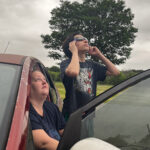
By Melody Mendoza and Shawna Mount
You probably don’t think about water much when you use it. You turn on the faucet and the water is right there at your fingertips. For most of us, the city’s water management system is out of sight and out of mind. But a new outreach effort by San Antonio Water System lets the public see the process water takes, from rain to drain.
Consider this: We should drink eight glasses of water a day. We flush 29 gallons of water a day. And about 70 percent of the Earth’s surface is covered by water. Every eight seconds, a child dies from a water-related cause amounting to 4,000 children per day, and 1.1 billion people worldwide are without safe water.
Those vast statistics, all related to water use and consumption, are covered in detail during San Antonio Water System’s free Rain to Drain tour offered nine times a year. The tour is open to the public, and breakfast and lunch is provided.
The day-long tour takes a pre-registered group to three locations across San Antonio — Stone Oak Parkway, where water floods into caves that go directly into the Edward’s Aquifer, Maltsberger Pump Station, where water is stored and treated, and lastly to Dos Rios water treatment plant, where waste water is treated and recycled.
The tour, which SAWS has been hosting for four years as part of the utility’s overall education process, offers an inside look at resource management and walks observers step by step from rain to drain. Most of SAWS educational programming is aimed at educating youth and education specialists offer sessions to local elementary, middle and high school students. To view a list of upcoming tours, visit the SAWS website.
Education specialist Greg Wukasch said April 30 in an email, “We as Americans take our water for granted so our hope is that this tour makes us more mindful of our water supplies and distribution system. We want people leaving saying, ‘Wow, I had no idea.’”
The tour
On the morning of the April 14 Rain to Drain experience, Wukasch, the tour guide, welcomes and signs in attendees in the Customer Service Center at SAWS central office, 2800 U.S. Hwy 281 North. The room is filled with more than 30 people, mostly residents of San Antonio and many retired educators. Wukasch gives a short introduction to the tour and tells the audience that he’ll give an overview presentation of water from rain to drain before the three location visits.
During the presentation, he says SAWS serves its customers in four ways — water, waste water, recycling water and heating and cooling.
The system has 144 million gallons of water in storage, and 10,000 miles of water, sewer and recycled water pipes in San Antonio.
There are three zones — drainage, recharge and artesian zones — that Wukasch goes over in detail in order to explain the process that water goes through from rain to drain. The recharge zone falls over the central and northern parts of Bexar County, from the Helotes area to the Stone Oak area. The artesian zone is directly under the city and stores water.
The Edward’s Aquifer is enclosed by two layers of clay, which creates pressure. This causes any drilling into the aquifer to release a spring of water from underground when an artesian well is dug.
One common misconception is that many people think the Edward’s Aquifer is a giant underground lake. Another is that when Stage 1 water restrictions are announced, the city is going to run out of water. Both are false.
Wukasch says restrictions are about maintaining the level for endangered species in San Marcos and New Braunfels. He explained in an email May 3 that SAWS is regulated by the Edwards Aquifer Authority as to how much water we can pump from the aquifer. The EAA is charged by the state of Texas for maintaining the aquifer level so that the springs in New Braunfels and San Marcos won’t go dry, since endangered species live in those springs. So, when it is hot and dry, SAWS puts limits on water use, so that it will limit our pumping from the Edwards Aquifer.
During the tour, he also says water goes from west to east, therefore most of San Antonio’s recharge comes from Medina/Uvalde county. Wukasch says SAWS is looking to purchase land from the west.
He explains that SAWS and the EAA have implemented programs in the county, like in Stone Oak Parkway, and west of the county that allow SAWS to purchase land or go into contracts with landowners to make sure they never develop their land.
“The land that we look for must be part of the recharge zone of the Edwards Aquifer. This allows us to protect valuable Edwards Aquifer recharge zone land from pollution sources as well as allow recharge to occur,” Wukasch wrote.
Stone Oak Parkway, the heart of the recharge zone
Although 86 percent of the recharge zone located in Stone Oak Parkway is already developed, SAWS purchased the parkway to conserve the rest of the zone.
Looking upward from the park, a hill encompasses the park and houses peak out from there. Stepping off of the bus, a gravel walkway leads the group to a dam that was built in the park.
Everyone is silent as they listen to the audio commentary from a small mp3 player at each stopping place.
The next stops are two caves in the parkway where water goes straight into the aquifer when it rains.
The Bear Cave is the largest cave in Bexar County, and although it’s about 250 feet long, you can only see a small opening. The rest of the cave’s opening is covered with a cage-like structure. The audio commentary explained that a man became stuck in the cave.
Another cave in the parkway is Cub Cave, which is open and you can see all the way into it. As the group stumbles down rocks onto a lower level, they line up along the edge of the cave looking into the hovering wall. Wukasch said rock climbers sometimes use the cave for training because of its hovering structure.
Maltsberger Pump Station
Although we pass many water storage tanks as we drive on the highway, at first glance, the storage tank appears larger. As the group steps off the bus, the tank is suspended over their heads.
Large tan pipes come up from the ground, extracting water from the artesian zone and treating it with chlorine and fluoride, which Wukasch says keeps the water clean through underground pipes where bacteria can build up. Then, the water is transferred in blue pipes into homes.
Wukasch says tower storages are used to create pressure and to send water north and uphill.
Dos Rios
An almost 30 minute shuttle ride south of the storage tank sends participants to Dos Rios waste water treatment plant, one of SAWS’ three waste water treatment plants.
The first step is to rid the water of any solids before running it through the filtration system, which is called screening. As the group walks closer to the machine that extracts solids from the water, the more the air smells like sewage.
Wukasch says everything that is flushed down the toilet or comes down the drain shows up at the plant. A chip bag, condom and plastic items were some of the visible things seen coming out of the water at the plant.
And although the smell makes you think differently, the water includes biological, chemical and physical waste, and is actually 99 percent water.
In the next stage, the grit chambers, the water is slowed down allowing grit like sand to sink to the bottom and allow the water to continue to move through the treatment process.
After that, the primary clarifiers scan the top of the water, which allows solids like grease, oil and hair float to the top and are skimmed off.
Then water moves to the aeration basin where pure oxygen is given to the microbes that are already in the wastewater, which causes them to eat quicker than normal and therefore helping to clean the water even more.
Chlorine is then poured into the water to kill the microbes, and some water containing the microbes is recycled by archimedes screw pumps to reseed the microbes back into the aeration basins for additional filtrations.
Before releasing the water into the environment, sulfur dioxide is put into the water to detoxify the chlorine.
Waste taken from the water is created into compost for non-edible plants. It takes about 30 days to breakdown. Methane is created from the process of breaking down the solids called digesters, so during the treatment process, SAWS is now recycling the methane into a green energy supply.
After the day-long tour, many people express their personal gratitude to Wukasch, thanking him for the time to inform them on making transparent an extensive and interesting process.
And SAWS has seen the results of their education efforts. Not only does the tour clear up many common misconceptions for the public, conservation efforts have also ranked San Antonio as a highly regarded leader in water conservation.
[divide style=”3″]






